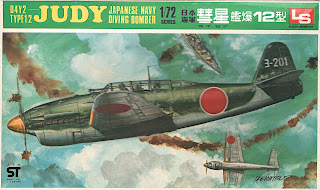- G3M1 Model 11/21 with parts for either early or late versions with flat-topped or domed turrets
- G3M2 Model 23 with 'turtle shell' dorsal turret
- L3M1 Type Nippon-Go which could be completed as the civilian trail-blazing and world circumnavigating pioneer J-BACI with alternative decals for J-BEDA Soyokaze-go, J-BEOC Yamato-go, J-BEOG Matsukaze-go, or IJN transports from 1 and 1001 Ku
- Type 4 Ki-67 bomber
- 'Yasukuni' Ki-67 torpedo bomber
- Ki-109 Interceptor
In 1972 LS released a completely revised 'Judy' kit, moulded in pale grey plastic and with the nose halves separate from the fuselage halves in order to facilitate release of a companion D3Y3 Model 33 variant with radial engine. According to 'Encylopedia of Military Models 1/72'* this release was also lengthened to match 1/72 scale. The original kit was further enhanced with boxed in wheel wells and a rudimentary cockpit interior consisting of floor, seats, instrument panel, compass, joystick and machine gun. Two crewmen apparently closely modelled on the aliens from Invaders from Mars (1953) could be sat somewhat awkwardly on those seats but were a poor replacement for the original seat bound pair who were actually not that bad. Unfortunately the kit retained the engraved Hinomaru positions and the decal sheet was reduced to providing just eight Hinomaru. Although the new box art by one Ikematsu (shown above) depicted Yo-201 (without the tail stripes) no tail code decal was included. Other improvements were a complete optical sight very finely moulded to the fuselage halves, a separate intake with splitter plate and more finely moulded undercarriage legs with commendably thin wheel covers. The working bomb bay doors and bomb were gone with the doors now moulded integrally with the fuselage halves and closed. There was no stand included.

The D4Y3 Model 33 was released the same year as the revised kit, but moulded in dark green plastic and in a box marked both No.7 and A107:100, It was identical to the earlier kit except for the provision of new cowling parts, consisting of two halves and front with a two-part twin row radial engine. Box art was again by Ikematsu, shown above. The 'fatal flaw' of both kits was the too narrow fuselage in plan view. That slim fuselage could be fattened with plastic shims but that spoilt the fit of the canopy. In 1983 the Fujimi release of the D4Y2 and D4Y3 in 1/72 scale effectively supplanted the LS kits and in 2012 AZ Model also released a family of 1/72 Suisei kits. Both the Fujimi and AZ Model Suisei families included the night fighting D4Y2-S variant with oblique armament.
* Encylopedia of Military Models 1/72' by Claude Boileau, Huynh-Dinh Khuong & Thomas A Young, English language edition. by Airlife Publishing Ltd., England, 1988
To be continued . . .
Image credit: All © 1966-1983 L & S Co., Ltd.









6 comments:
Thanks Nick,
Another nice presentation with info 'new' to me at least, as to how this company developed and grew. Must have been a big leap from single-engine projects to the Nell and Peggy variants, which were admirably managed in ways that, as you mentioned, were less daunting for all their detail, and friendlier to the modeler because the maker met the builder without any sawing of plastic or compromise of variant differences tht were fudged through omission. Clicking upon the group picture of finished models included shows some fine work and good looking builds, even if certain shapes are understandably rendered better by later molds from others.
The name Ikematsu rang a bell. I pulled out some of my earliest Maru Mechanics and that single name, though discreet, is signed in English on the cover art of #4 (Zero) and #5 (Sam). Another great post for A of J 'kitology.'
Fascinating indeed!
The L3M1 Type Nippon-Go with the captivating orange-colored sky remains one of my all-time favorite box art depictions!
Gratitude Nick
Thanks for your comments Mark and Rob. Those early LS G3M and Ki-67 box arts have tremendous nostalgic appeal.
Regards
Nick
Thank you very much, Nick.
It's very interesting to bild the "Oldtimers". There are rather many modellers who build "As is". All D4Y of various production for example.
Another splendid review. I think, early G3M and L3M are rather popular kits now. No choice.
Thanks for the kit histography, Nick. I got all but the last boxing in your report, way back in the day.
Ken Glass
Post a Comment